Fes old medina (I): smells and prayers – Morocco
On September 25th, 2015, I flew from Bucharest to Fes early in the morning. At midday, I had a stopover in Brussels – Charleroi, the airport dedicated mainly to low-cost flights. Some people sat and waited for their next flight on a concrete parapet in front of the airport. So I did the same for a while, then nibbled a snack at one of the airport’s fast-foods before on-boarding on my second flight. In the afternoon, I landed at the airport in Fes, which featured modernist architecture with a local imprint. I filled out the visa application form and waited for my checked baggage at the baggage claim area. In front of the modest airport, my driver, Fouad, was waiting for me.
Milouda was the landlady of riad Casa Aya Medina, where I was about to stay for a few nights. I had asked her to send someone to wait for me at the airport. She had told me a fair price, which I had double-checked in the Lonely Planet guide (15US$), and accepted her airport-ride offer. Fouad, the driver who was waiting for me, drove me in his luxurious car to Fes. He was attentive and gallant. He gently sneaked a business card in my hand and strove to chat with me in English.
In Fes-el-Bali (medina – ‘old town’), Fouad parked the car near the school and mosque in Ain Azletin neighborhood. From there, we walked along a narrow street in the medina and suddenly turned left on a dead-end back-street. A few children somehow managed to play with a ball on that tiny passage. Eventually, Fouad knocked at a door at the end of the alley, and Mohamed (an employer of the riad) opened the door and welcomed us.
In the lounge (taklidi) of the riad, Mohamed served me Moroccan tea with crispy cakes (fkas and ghriyba) cooked by his mother. Then, he told me I could choose to stay in any room in the riad because there were no other guests at that moment. As I was talking with Mohamed, I learned the difference between a riad, a dar, and a house in Morocco. Riad is a traditional palace with an inner courtyard centered around a fountain and a small garden, and many guest rooms on the upper floors. Dar is an authentic Moroccan house with a modest patio and four to six guest rooms on the upper floors. Similarly, a house accommodates only one family and has no guest rooms.
Milouda had accepted me to stay in her riad for four nights in exchange for an article about Casa Aya Medina on my travel blog. In the evening, she came with her boyfriend to the riad and personally greeted me. Milouda told me the muezzin used to sing the first call-to-prayer of the day at 5 a.m. every morning. She noticed I didn’t like that and added she could take me on a medina tour the following day. Then, Mohamed also invited me to have dinner with his family. I was tired though, so, sadly, I had to put it off for the following day.
Fes, the first day – the old medina
Short Description. I went on a tour of the medina (Fes-el-Bali) with Milouda and three Japanese girls. We explored mosques, Koranic schools, and all kinds of shops. Later, I explored the medina by myself. In the evening, I went with Mohamed to have dinner with his family in the Merinids neighborhood.
Long Description.
Mohamed served me breakfast in the patio of Casa Aya Medina every morning. Traditional Moroccan mint tea, small cakes, cornbread-sized-grain made of semolina, classic melted cheese, and fruit jam. I asked him to call Milouda for the promised medina tour, but she was already on the run with a group of three Japanese girls. Eventually, she managed to quickly pick me up from the small parking lot in Ain Azletin square.
The spiritual and imperial capital of Morocco, Fes held the largest medieval medina in the world, over 1200 years old (listed as a UNESCO World Heritage Site). The town of Fes had been invaded several times by Berbers, Almoravids, Almohads, and Merinids. Besides, at the beginning of the 20th century (1912-1956), it fell under the power of the French Protectorate. Thus, Fes was the oldest Imperial City in Morocco – dubbed Mecca of the West, the Athens of Africa, and the Capital of Handicrafts.
The medina in Fes held a labyrinth of streets bustling from early morning (from the first call-to-prayer) until late at night when the last tourists ended their shopping. The medina was a living swarm, full of smells, colors, cries, incantations, and prayers. A complex urban system (without pre-established urban planning) under continuous transformation. An amalgam of alleys (derbs), dead-ends, squares, or empty plots, houses, and riads.
In the medina, you could find anything. Houses with secret inner courtyards, well-hidden from the street and protected with mashrabiyya (wooden-perforated screens). Mosques with madrasas (Koranic schools), hammams (public baths), and funduqs (old inns). Seqqayas (public fountains) decorated with zellij (tilework), zawiga (shrines), and souqs (markets). Bakeries, tanneries, and various shops endlessly lining along the winding streets. Signs in all languages. Vendors shouting out their prices to attract customers. And, the worst of all, the smell of the dried sheepskins stunk everywhere.
We started our tour at Bab Boujloud (the Blue Gate), one of the entrance gates in the medieval medina and a former water tank for the old town. The three Japanese girls (Chiaki, Ayumi, and Vora) did not speak English. Therefore, Milouda had to talk to them only using signs and smiles. We walked down Talaa Kbira, the largest and longest pedestrian street in the medina. The street was packed with street vendors, various shops, and religious complexes. A dead rat lay on a street corner and big animal bones were abandoned behind shopping stalls. In that messy, new world, I had to adapt to different rules of hygiene and cleanliness.
Commercial, artistic, and intellectual center, Fes had been embellished with elaborately decorated monuments during the Merinids and Almoravids dynasties. Mosques, mausoleums, public fountains, as well as hammams and riads displayed the following triad. Tilework (zellij), elaborate and often colored stucco plaster, and painstakingly carved and painted friezes in cedarwood. Across the Madrassa Bouananiya, there was a hydraulic clock, nonfunctional though. In the heart of the medina, Zawiga Moulay Idriss Al Azhar housed the tomb of the Great Idriss II, the founder of Fes, and Zaouiat Sidi Ahmed Tijani Shrine housed the relics of a saint. It also served as a pilgrimage outpost for Muslims coming from Algeria, Mali, Nigeria, and Senegal and going to Mecca. A bit further, the Quaraouiyine Mosque housed an Islamic center with the first multidisciplinary university in the world.
Talaa Sghira was the other main pedestrian street in the medina, shorter and narrower, though. We stopped at a public bakery where a sweaty Moroccan put round bread dough to bake in a large earth oven. Then, we passed the symbolically named restaurant ‘La Medina’ with typical Moroccan interior design. After that, we entered a leather shop preceding the famous Chaouwara Tanneries.
The Chaouwara Tanneries are the largest in Morocco. In the tanneries, several young Moroccans first soaked sheep hides in liquids made of cow urine, pigeon feces, quicklime, salt, and water. Then, the local workers dyed them in dozens of different pits. The smell of sun-dried sheep hides was terrible, though. We avidly inspired the aroma of some fresh mint leaves as an antidote. Eventually, we somehow avoided buying leather clothes and slippers or handbags in that shop. But after that, we entered other shops with pottery, basket weavers, slipper makers, blacksmiths, kaftans, and djellabas.
A normal day in the medina of Fes. Children ran and played in dusty yards. Mules were the only means of transportation in the medina. They trotted heavily loaded up with everything, including gas tanks imported from Algeria. You could frequently hear ‘Balak, balak’ shouted out on the narrow streets when mules were taken to supply the most obscure and dark corners of the medina. Skinny yet friendly cats and small kittens slept wherever someone fed them. Embittered beggars didn’t even dare to ask for money. Street vendors tried to make money out of anything – from selling napkins and cigarettes to small drums and silky shawls. Shop owners were sipping their countless tea glasses while sitting in front of their shop windows.
We entered a silver shop in the neighborhood of Nejjarine Market. There, according to the Moroccan tradition, the Japanese girls negotiated and had tea for at least one hour. While Vora and Ayumi were bargaining, Chiaki was filming them. Then, at Dar Ibn Khaldoun carpet shop, we stepped barefooted on the loom-made rugs to feel their softness. In a courtyard, we witnessed how a Moroccan weaved silky shawls on an old, traditional loom. Eventually, we ended our tour in a herborist shop with herbs, cosmetics, perfume extracts, and Argan products. At the end of the medina tour, we took a taxi from Bab Guissa. The three Japanese girls and Milouda continued their ride toward another part of the medina while I got off at Bab Boujloud.
Close to Bab Boujloud, I had chicken brochette at Salon de The Fassi Boujloud. There, I also had the first shock when I entered the public restrooms – a place of unimaginable dirt. Then, I bought a local SIM card in a small shop crammed between other houses and headed toward the labyrinth of the medina. I bought some sweets (a kind of nougat) from a peddler, but I gulped them nervously after I saw how many flies swarmed around them.
In the medina, I entered Kaftan Saada to get an idea of the traditional Moroccan clothing (katfans and djellabas). Then I stopped for a glass of tea at Ali’s carpet shop. Later, I entered Funduk Qaat Smen – a caravanserai with honey shops in the courtyard, and Funduk Tazi – a former inn with pottery shops in a shabby courtyard. Eventually, I stopped at the Herboriste Nomade shop, where I smelled all sorts of perfume extracts and menthol for asthma.
Fake guides tried to fool me everywhere in the medina. They often told me: ‘the medina is closed, this way, no, madame, come here.’ In that situation, you wondered and were confused. At that moment, the fake guides offered to save you and show you the right way, then they asked for money. Or, they said: ‘here, nice place, beautiful, come, come.’ You were curious, followed them to see the place because otherwise, you wouldn’t have found it, and eventually, they again asked for money.
Nothing was for free in Morocco – everything was an exchange, a bargain, a business, an agreement. This way, I managed to explore the hidden Loscurtedores Tanneries and a nearby inn. I stubbornly paid only 7 Dirhams to the fake guide despite his smart, insistent efforts to charge me more. I activated the GPS on my smartphone to get home, but sometimes it didn’t find enough satellites on the narrow streets of the medina. Luckily, I found my way toward Casa Aya Medina without the help of other fake guides.
A traditional Moroccan dinner in Fes
In the evening, I went with Mohamed to have dinner with his family in the Merinids neighborhood, somewhere outside the medina. The quarter had shabby gray buildings, a swarm of people, street merchants, and even barbecues in the street. People were still celebrating Eid on September 24th, 2015. The Eid is the Sheep Feast, a Muslim celebration in honor of the Prophet Abraham, who was asked by God to sacrifice his only son. Muslims say that when God saw Abraham’s deep faith, he sent him a sheep-messenger to tell him not to kill his son.
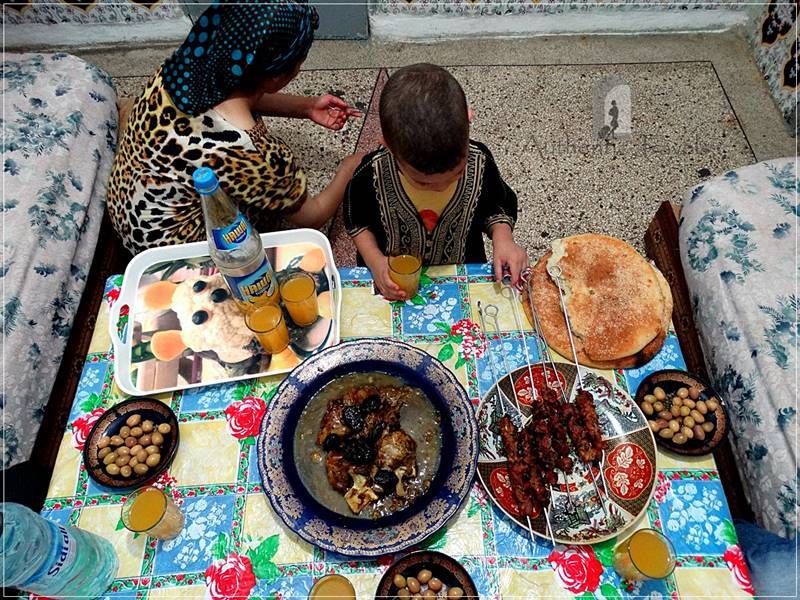
Fes (the Merinids neighborhood): dinner with Mohamed’s family (tajine aux pruneaux and mjmar with sheep meat)
Once we reached the Merinids neighborhood, we went to the flat of Mohamed’s brother, Najib. Najib lived with his wife – Samira, and their son – Youssef. Then, we climbed upstairs to another apartment where Mohamed lived with his mother – Milouda, and his sister – Fatiha. Both flats had a living room decorated with black-flower tiles and a sofa disposed on three sides of the room (the traditional oriental style). The kitchen and the bathroom (a Turkish toilet where you had to flush water using a bucket) comprised only the minimal requirements. Only the women shook hands with me and kissed me on the cheeks. Instead, Najib greeted me from a distance.
We served Moroccan tea in small glasses, with fancy biscuits, green olives, and Hawaii orange juice. Milouda and Samira made barbecue (mjmar) in a tray placed on the floor in the dining room or outside the flat, on the staircase. We had lamb tajine with plenty of plum sauce (tajine aux pruneaux) and sheep brochettes. Even though it seemed tasty, I had to face the challenge of the evening. I had to eat everything with my hands, only with the help of a piece of flatbread. After dinner, we returned to Casa Aya Medina past the Borj Nord fort and the ruins of the former Merinids tombs. From there, you could see the whole medina of Fes with thousands of lights glittering down in the depression.
Fes old medina (I) is the first travelogue about Fes, Morocco. Its continuation, the second post, can be found at the following link Fes old medina (part II). And here are all the Travelogues from Morocco (x21).
Have you been to Morocco or plan to go there? Leave a comment below this post and tell me what you liked in Morocco or what you want to see there.
Want to subscribe to my travelogues? Just leave your email in the subscription form below, and you’ll be notified when I publish a new post.
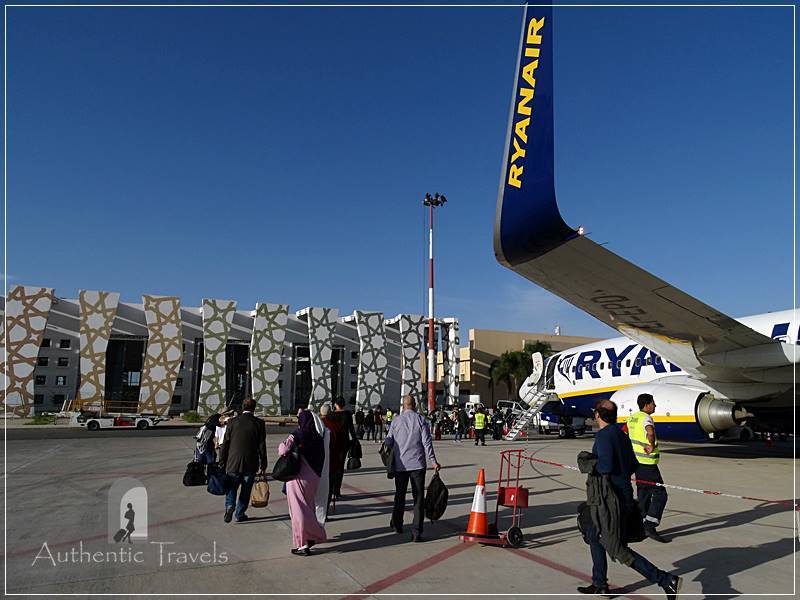
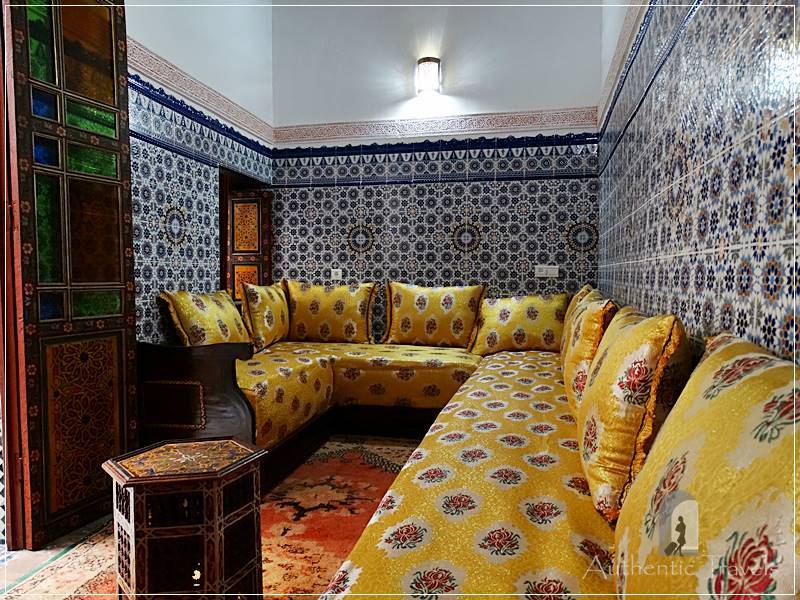
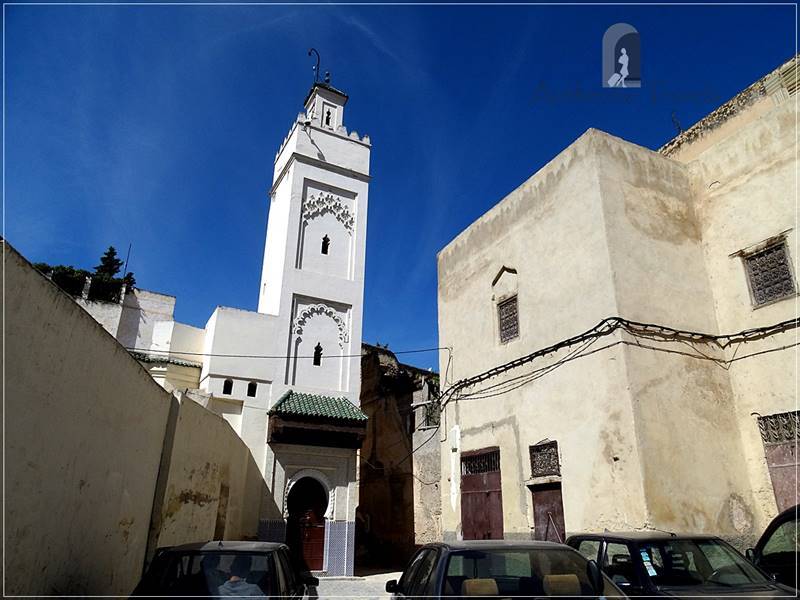

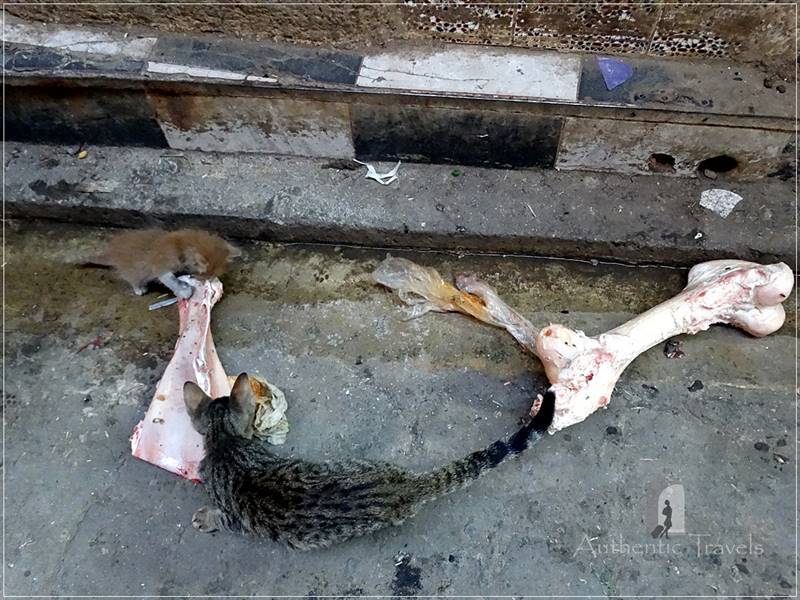
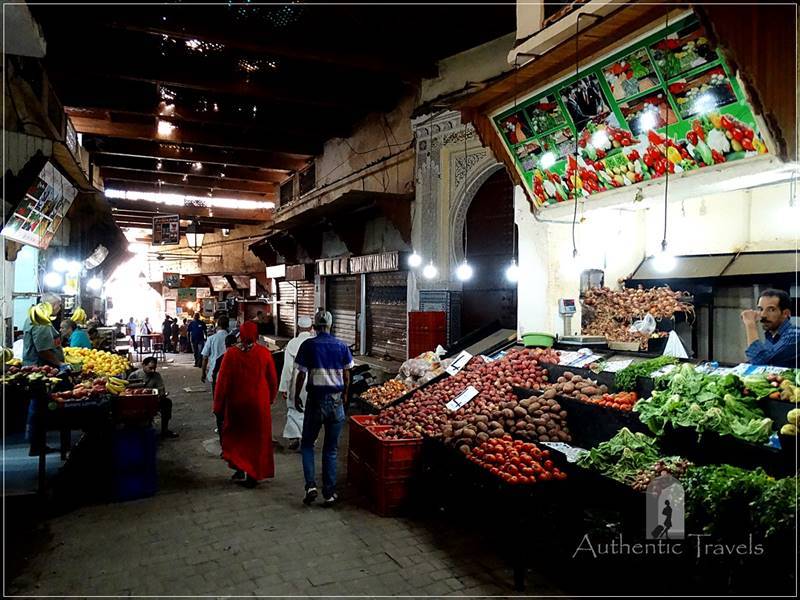
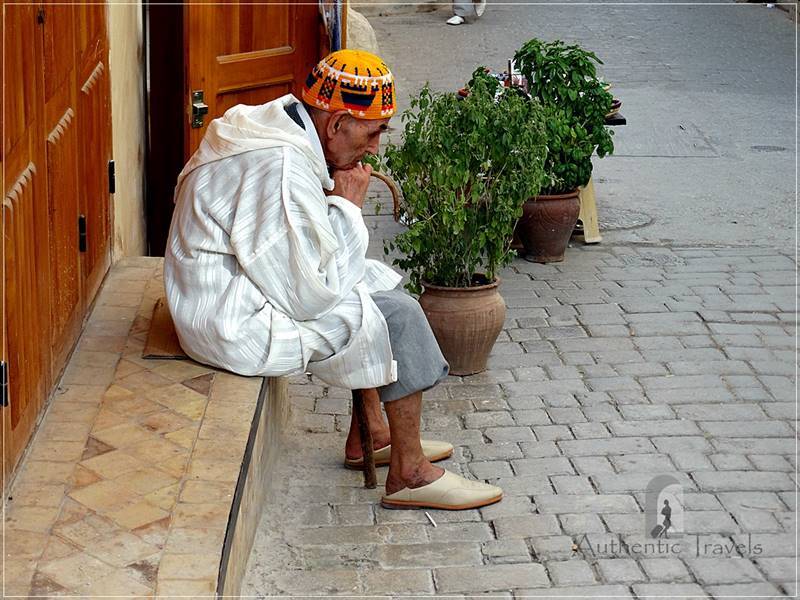

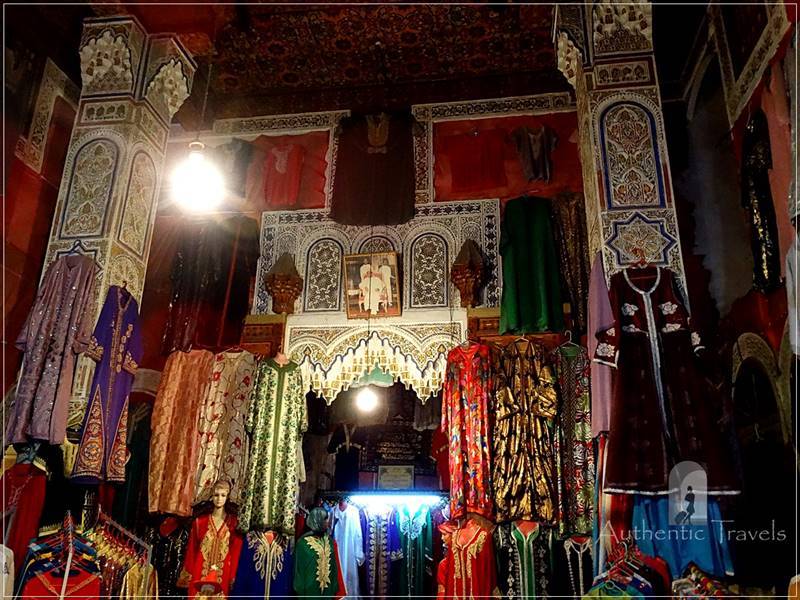
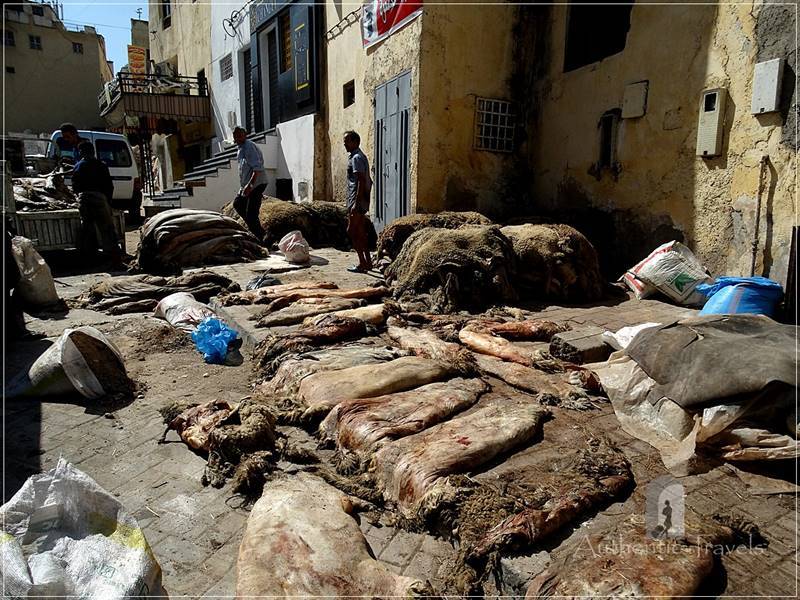
I have heard lot many interesting things about the culture of Fes and it always tempted me to book my tickets to Morocco and visit this little cute place. I love to stroll around and see the authentic souks, life of locals with their daily activities and therefore old Medina in Fes looks wonderful. Berber carpet shop and Talaa Kebira with a market in the street catches my attention. Blue gate looks beautiful here.
The old medina of Fes is a true experience in Morocco. Just think that it has been listed as a UNESCO-site for a reason. When I hear a place is a UNESCO heritage, I immediately know I must go there. Thx for your nice words
Fes is high on my wish list of travels. Visiting a medina is #2 of the things I want to see and do in Fes and Morocco. Thanks for explaining the difference between a Riad and a Dar, I always wondered about this. Your Riad looked beautiful and lucky that you could choose which room as well. I enjoyed your photos!
Fes’s medina is the oldest medina in the world. I would say that it’s the number 1 thing to visit while you are there.
I love all the cultural insights that you have shared in this post. The dinner with Mohamed sounds like it would have been such a great experience. There is no better way to experience a culture than by spending some time with the locals and experiencing lie how they do. It is always so interesting to see how different things are in different parts of the world. Eating with just your hands and a piece of bread must have been tough!
At that moment, it seemed to me the toughest thing to eat with my hands. Now, I appreciate and I am grateful for that experience.
Morocco has always been on my bucket list and Fes on my Moroccan itinerary. It is such a beautiful, historical place. I am glad that you have included bits of history to show us the relevance of all the amazing things to do in Fes. I am a big history lover and Fes is a must-do destination for me. So happy to come across your post. I learnt something new here i.e. about the Chaouwara Tanneries. Will check them out. Lovely pictures, by the way.
Thank you for your appreciation, Soumya.
Wow! This is a nice experience. I have never been to Fes but would love to visit. The place seems to have a very rich history and culture and would love to learn more. Good to know that you were able to find your way around town without the help of the fake guides.
Indeed, Fes is a great place (and medina) to explore in Morocco.
Iuliana, thank you for this delightful post on Fes! It brought back so many lovely memories for me, but sadly I didn’t have the time to experience all of the things you came across – I will keep a mental note if I am ever fortunate enough to visit again. Thank you!
I think that each country needs to be explored more in depth.
After reading your post, I am so fascinated to visit Fes’s medina . You have given such a vivid description of the place including local lifestyle, markets, food etc. I am big fan of Moroccan carpets, tiles and also food. You have given me all the reason to make my plan. Loved reading the detailed post.
You’re welcome. Medina of Fes is great but there are also other medinas that feature great authenticity.
Fes looks like a interesting place and glad that you had time to intreact with locals in this trip. Would love to go back to Morocco someday for sure. Moroccon Tea is also world-famous. Hope you had a lovely time exploring Medina with Japanese girls and by yourself. Have heard about fake guide scams in Morocco, glad you escaped. Eid is a lovely time to visit if you want to expereince the culture and learn more about it.
Actually, I was in Fes exactly during the Eid. It indeed impacted positively mt trip.
Great insight about this cultural and historic location with beautiful pictures to illustrate. Morocco is a place that I hardly know about and hence it was really interesting to run through so much to get of what all to do.
Thank you for your appreciation.